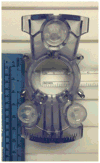Interventional MRI-guided catheter placement and real time drug delivery to the central nervous system
- PMID: 27054877
- PMCID: PMC5553275
- DOI: 10.1080/14737175.2016.1175939
Interventional MRI-guided catheter placement and real time drug delivery to the central nervous system
Abstract
Local delivery of therapeutic agents into the brain has many advantages; however, the inability to predict, visualize and confirm the infusion into the intended target has been a major hurdle in its clinical development. Here, we describe the current workflow and application of the interventional MRI (iMRI) system for catheter placement and real time visualization of infusion. We have applied real time convection-enhanced delivery (CED) of therapeutic agents with iMRI across a number of different clinical trials settings in neuro-oncology and movement disorders. Ongoing developments and accumulating experience with the technique and technology of drug formulations, CED platforms, and iMRI systems will continue to make local therapeutic delivery into the brain more accurate, efficient, effective and safer.
Keywords: Interventional MRI; catheter placement; convection enhanced delivery; drug delivery; real time.
Figures








References
-
- Sampson JH, Archer G, Pedain C, et al. Poor drug distribution as a possible explanation for the results of the PRECISE trial. J Neurosurg. 2010;113(2):301–309. doi: 10.3171/2009.11.JNS091052. This reference highlights some of the challenges in clinical application of CED, and highlights the need for the ability to visualize infusions. - DOI - PubMed
MeSH terms
Grants and funding
LinkOut - more resources
Full Text Sources
Other Literature Sources
